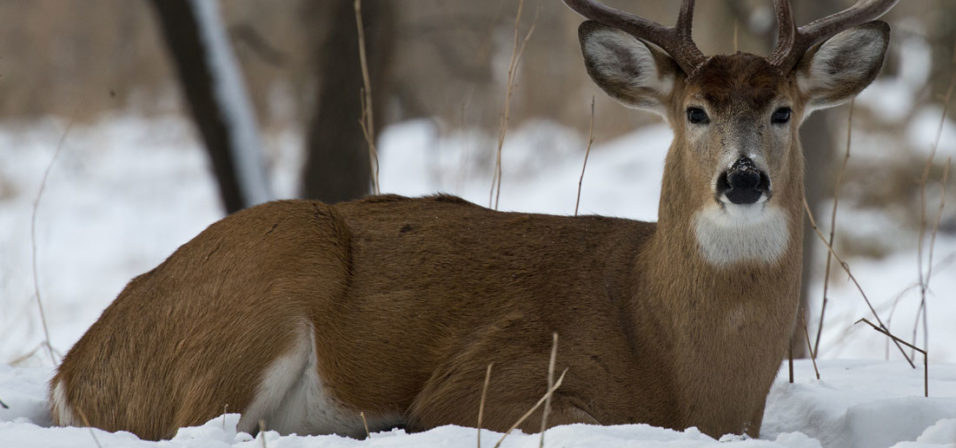The daytime bedding areas deer use will be located where they feel secure about their ability to detect and escape approaching danger.
When you’re out scouting bedding areas during the late winter/early spring prior to “green up”, ask yourself this question; “where do deer feel secure during the daytime in these parts”? It’s been my observation that areas that offer security attract deer to bed there. I’ve also noticed that these places continue to attract deer to bed there in daylight hours year after year.

A buck on his feet in daylight a few yards away from the security cover that he bedded all day in. Daytime bedding areas are a big key to success.
Large Predator Impact on Daytime Bedding Areas
In the big woods of the north country, large predators play an important role in where the deer feel safe. In many areas of the north, deer find they can avoid predators by sticking close to human settlements. Predators tend to shy away from areas where they encounter people. Deer have learned this and have moved into those backyards, finding it easier to avoid humans in our backyards than predators in the outback. They survive longer using this tactic. In agricultural areas, large predators are less of a problem. Here, adequate cover plays an important role determining where deer can survive. Finding hiding places where deer can avoid humans is a key ingredient to locating where deer spend their daylight hours. In urban places, spots that are close to areas closed to hunting (parks, golf courses, residential areas) can be the ticket to finding security for deer.
How Terrain Affects Deer Bedding
Deer will effectively use terrain features to aid in security while bedding to help avoid danger. Terrain features can provide cover, ability to funnel scent, improved ability to hear, and visual advantages that offer a deer residing there to detect an intrusion into their daytime hiding spot from afar. As long as a deer can detect an intruder before it gets too close to flee from, it can slip out the back door and escape unnoticed or decide to stay put and let the terrain keep it hidden while the intruder passes through. In either case the deer survives to live another day and grows more confident that its’ “secure spot” kept it alive and it can avoid detection there. Our Hill Country Bucks DVD details how to hunt hilly terrain for big bucks.
Sanctuaries Manipulate Deer Daytime Bedding Areas
This past hunting season, my family set aside a deer sanctuary on our farm, a place where we did not enter during the hunting season. The thirty acre spot attracted most of the deer on our farm and they stayed there during the daytime, mainly leaving to feed at night. The security of not having any human intruders held those deer there. If the refuge didn’t exist, these same deer would have a number of different places they would choose to bed in to avoid predators and hunters during daylight. The bedding areas may be spread out over distances of a half mile or more. Depending on wind direction to scent, or the ability to see or hear approaching danger, these places give advantage to a bedded deer to detect approaching danger. A westerly prevailing wind in one bedding area may allow deer to detect intruders approaching from afar, where a southerly wind would not. A deer chooses a bedding area based on weather conditions and the security it affords, when conditions change so may the bedding location. When you locate a bedding area kneel down in a bed and look around to see how a deer uses it to their advantage. Are they bedding there to be able to see, smell or hear approaching danger? What wind direction affords them to hear or smell approaching predators and hunters from afar? How can you be in position to hunt them without being detected when they enter or leave those spots? Knowing what bedding areas are used according to wind direction allows you to be able to effectively “play the wind” and hunt them by concentrating your efforts nearby. Learn more about hunting bedding areas, playing the wind, and terrain’s role in this in our instructional DVDs we have available.

One thought on “Daytime Bedding Areas Key When Scouting”